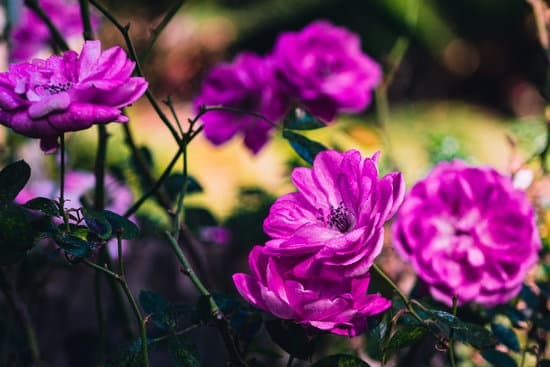Rockery gardens are a unique and delightful way to add texture, interest, and natural beauty to your outdoor space. These gardens, composed of carefully arranged rocks, stones, and plants, have been around for centuries and continue to captivate gardeners worldwide. In this article, we will explore various ideas for rockery gardens that can inspire you to create your own stunning rockery landscape.
The popularity of rockery gardens can be attributed to their numerous benefits. One key advantage is their low maintenance nature, making them a perfect choice for busy individuals looking to enhance their outdoor environment without extensive upkeep. Additionally, rockery gardens are inherently drought-tolerant, making them an eco-friendly option in water-restricted regions or for environmentally-conscious gardeners.
When considering creating a rockery garden, it is essential to choose the right location that meets the specific needs of these unique landscapes. Factors such as sunlight exposure, drainage patterns, and soil quality play a crucial role in determining the success of your rockery garden. By selecting an ideal location with proper conditions, you can ensure the longevity and vibrancy of your rockery garden design.
Benefits of Rockery Gardens
Rockery gardens are known for their unique aesthetic appeal, but one of the main reasons they have gained popularity is due to their practical benefits. One key advantage of rockery gardens is their low maintenance nature. Unlike traditional flower beds or lawns, rockeries require minimal upkeep once established.
This makes them an excellent choice for busy individuals or those looking to reduce the amount of time and effort spent on gardening tasks. With a rockery garden, you can spend more time enjoying your outdoor space rather than constantly working in it.
In addition to being low maintenance, rockery gardens are also drought-tolerant. The rocks and stones used in rockeries help retain moisture in the soil, which can be beneficial during dry spells or in regions with limited rainfall.
This means that even during times of water scarcity, your rockery garden can continue to thrive without the need for frequent watering. For eco-conscious gardeners looking to conserve water or those living in areas prone to droughts, a rockery garden is an excellent choice that aligns with sustainable gardening practices.
Another benefit of rockery gardens is their versatility when it comes to design options. Whether you prefer a minimalist look with sleek granite rocks and geometric shapes, or a lush oasis with cascading water features and vibrant alpine plants, there are endless possibilities for creating the perfect rockery garden to suit your style and preferences.
By carefully selecting the right types of rocks, plants, and design elements, you can customize your rockery garden to reflect your personality and create a tranquil outdoor retreat that enhances your home’s landscaping.
| Advantages | Details |
|---|---|
| Low Maintenance | Requires minimal upkeep once established |
| Drought-Tolerant | Rocks help retain moisture in soil for sustainable watering |
| Versatile Design Options | Create a personalized outdoor space that reflects your style |
Choosing the Right Location for Your Rockery Garden
Rockery gardens are a unique landscaping feature that can add texture, depth, and interest to any outdoor space. When considering ideas for rockery gardens, it is crucial to start by selecting the right location for this specialized garden. The success of a rockery garden highly depends on the amount of sunlight, drainage, and soil quality in the chosen area.
Sunlight is a critical factor when choosing the location for your rockery garden. Most alpine plants and succulents thrive in full sun conditions, so it is essential to select a spot that receives ample sunlight throughout the day. Additionally, consider how the sunlight falls on different areas of your yard at different times of the year to ensure that your rockery garden will have optimal growing conditions.
Drainage is another key aspect to consider when situating your rockery garden. Rock gardens require excellent drainage to prevent waterlogging, which could lead to root rot and other issues for your plants. Make sure the chosen site has proper drainage or consider implementing raised beds or additional gravel or sand layers to improve drainage if necessary. Moreover, take into account natural water flow patterns in your yard when determining the best location for your rockery garden project.
Soil quality plays a significant role in the health and growth of plants in your rockery garden. Ideally, you should aim for well-draining soil with good fertility levels.
If your existing soil does not meet these criteria, consider amending it with organic matter like compost or peat moss to improve its structure and nutrient content. Testing your soil before planting can provide valuable insights into its pH levels and nutrient composition, helping you make informed decisions about preparing the soil for your rockery garden.
| Location Criteria | Considerations |
|---|---|
| Sunlight | Choose a spot that receives ample sunlight throughout the day. |
| Drainage | Ensure proper drainage to prevent waterlogging and root rot. |
| Soil Quality | Aim for well-draining soil with good fertility levels; amend soil if necessary. |
Types of Rocks and Stones for Rockery Gardens
When it comes to creating a stunning rockery garden, the choice of rocks and stones is crucial in establishing the overall look and feel of the space. Different types of rocks and stones can bring varying textures, colors, and patterns to your rockery garden, allowing for endless creative possibilities. Here are some popular options for rocks and stones that you can consider for your rockery garden:
- Granite: Granite rocks are known for their durability and a wide range of colors, including shades of gray, pink, black, and white. They can provide a strong foundation for your rockery garden while adding a touch of elegance.
- Limestone: Limestone rocks offer a softer appearance with hues ranging from creamy whites to warm yellows. They are perfect for creating a more natural look in your rockery garden and are often used in creating pathways or border walls.
- Sandstone: Sandstone rocks come in various earthy tones such as reds, browns, and oranges, adding warmth and richness to your rockery garden. Their unique patterns make them ideal for creating focal points or accentuating specific areas within the garden.
By carefully choosing the right combination of rocks and stones for your rockery garden, you can create a harmonious landscape that reflects your personal taste and style. Experiment with different textures, sizes, and colors to achieve the desired aesthetic appeal for your outdoor space.
In addition to aesthetics, it is essential to consider the practical aspects when selecting rocks and stones for your rockery garden. Make sure to choose materials that are suitable for your local climate conditions and will withstand environmental factors like rain or snow. Proper planning in selecting rocks and stones will ensure a long-lasting and visually appealing rockery garden that you can enjoy for years to come.
Designing Your Rockery Garden
Designing a rockery garden can be a creative and rewarding experience, allowing you to create a unique and visually appealing outdoor space. One key aspect of designing a rockery garden is incorporating elements that complement the natural beauty of rocks and stones.
Cascading water features are a popular choice for rockery gardens, adding movement, sound, and a sense of tranquility to the space. Whether it’s a small bubbling fountain or a meandering stream, water features can enhance the overall aesthetic of your rockery garden.
When it comes to choosing plants for your rockery garden, alpine plants are an excellent option due to their ability to thrive in rocky, well-drained soil conditions. These hardy plants come in a variety of shapes, sizes, and colors, making them versatile choices for adding texture and interest to your rockery garden.
Succulents are another fantastic choice for rockery gardens, as they require minimal watering and maintenance while adding a unique touch with their diverse shapes and hues. From spiky agave plants to cascading sedums, succulents can provide year-round appeal to your rockery garden.
Incorporating both alpine plants and succulents into your rockery garden design can create a harmonious blend of textures, colors, and forms. Arrange these plants strategically around rocks and boulders to create visually appealing groupings that mimic natural landscapes.
By integrating cascading water features along with carefully selected plants, you can achieve a stunning rockery garden that not only looks beautiful but also provides habitat for wildlife such as birds and butterflies. Creating balance between hardscape elements like rocks and softscape elements like plants is key to achieving a cohesive and well-designed rockery garden that will be enjoyed for years to come.
Incorporating Wildlife Into Your Rockery Garden
Rockery gardens are not only a stunning addition to any outdoor space but also a perfect habitat for attracting wildlife such as birds and butterflies. By incorporating elements that appeal to these creatures, you can create a harmonious ecosystem in your rockery garden that enhances its beauty and provides a sense of tranquility.
One way to attract birds and butterflies to your rockery garden is by providing sources of food and shelter. Consider planting native plants that produce berries or seeds that serve as a natural food source for birds. Additionally, having flowering plants like lavender, butterfly bush, or milkweed will not only add color to your garden but also attract butterflies with their nectar-rich blooms.
To further entice birds and butterflies into your rockery garden, consider adding features like birdbaths, bird feeders, and butterfly houses. These additions offer essential resources for wildlife while also adding visual interest to your garden. By creating an inviting environment that meets their basic needs for food, water, and shelter, you can enjoy the delightful presence of these creatures in your outdoor sanctuary.
Incorporating wildlife into your rockery garden not only adds life and movement but also contributes to the overall health of the ecosystem. Watching colorful butterflies fluttering among the rocks or hearing the cheerful songs of birds can bring a sense of joy and peace to your outdoor space. With thoughtful planning and consideration of wildlife-friendly elements, you can transform your rockery garden into a thriving oasis that supports biodiversity while showcasing its natural beauty.
- Plant native plants that provide food sources for birds
- Include flowering plants like lavender or butterfly bush to attract butterflies
- Add features such as birdbaths, bird feeders, and butterfly houses
Maintenance Tips for Rockery Gardens
Rockery gardens are not only known for their aesthetic appeal but also for their low maintenance requirements, making them a popular choice for many gardeners. Proper maintenance is key to ensuring that your rockery garden remains healthy and vibrant throughout the seasons. This section will explore essential tips on pruning, weeding, and fertilizing to help you keep your rockery garden in top shape.
Pruning
One important aspect of maintaining a rockery garden is proper pruning of plants to promote healthy growth and maintain the desired shape. When selecting plants for your rockery garden, consider choosing those that do not require extensive pruning or trimming.
For plants that do need pruning, such as shrubs or trees, make sure to use sharp tools to make clean cuts and avoid damaging the plant. Regularly inspect your plants for any dead or diseased branches and remove them promptly to prevent the spread of diseases.
Weeding
Weeds can quickly take over a rockery garden if left unchecked, competing with your prized plants for nutrients and sunlight. Regularly check for weeds in between rocks, crevices, and around plantings, pulling them out by hand or using appropriate tools. Consider applying mulch or landscape fabric around your plants to suppress weed growth and reduce the need for constant weeding. Be diligent in staying on top of weed removal to maintain the overall health and appearance of your rockery garden.
Fertilizing
Fertilizing is another essential aspect of maintaining a thriving rockery garden. Different types of plants may have varying nutrient requirements, so it’s crucial to understand the specific needs of each plant species in your garden. Choose a balanced fertilizer specifically formulated for rockery plants and follow the instructions on the packaging for application rates and frequency.
Avoid over-fertilizing as this can lead to nutrient imbalances or burn the roots of your plants. Regularly monitor the health of your plants and adjust your fertilization schedule accordingly to ensure optimal growth and blooming. By incorporating proper pruning, weeding, and fertilizing practices into your routine maintenance schedule, you can enjoy a healthy and beautiful rockery garden year-round.
Inspiration for Rockery Garden Themes
Rockery gardens offer endless possibilities for creating a stunning outdoor space that is not only visually appealing but also low maintenance and drought-tolerant. From the serene simplicity of a Japanese Zen rock garden to the lush oasis vibes of a desert landscape, there are numerous themes to choose from when designing your own rockery garden.
When considering ideas for rockery gardens, one can draw inspiration from nature and different cultures to create a unique and personalized outdoor oasis. For those seeking tranquility and balance, a Japanese Zen rock garden with carefully raked gravel and minimalist plantings can provide a sense of calm and contemplation. On the other hand, a desert oasis theme featuring cacti, succulents, and ornamental grasses can bring a touch of the Southwest to your backyard.
For a whimsical and enchanting feel, consider incorporating fairy garden vibes into your rockery garden design. Use small pebbles or rocks to create miniature pathways, add tiny fairy figurines among the plants, and even install tiny ponds or water features for an added magical touch. This playful theme is sure to delight both children and adults alike.
In conclusion, whether you prefer the peacefulness of a Zen garden, the beauty of a desert landscape, or the charm of a fairy garden, there are endless ideas for rockery gardens to explore. By choosing the right location, rocks and stones, plants, and design elements that resonate with you, you can create a unique outdoor sanctuary that brings joy and tranquility for years to come.
Remember that maintenance is key in ensuring your rockery garden thrives, so be sure to follow proper care techniques outlined in this guide to enjoy your beautiful creation to its fullest potential.
Frequently Asked Questions
How Do You Layout a Rock Garden?
Creating a rock garden involves careful planning and design. Start by selecting the location with proper sunlight and drainage. Clear the area of any debris and weeds before adding rocks of different shapes and sizes. Plant low-maintenance, drought-tolerant plants for a visually appealing rock garden.
What Plants Are Best for a Rockery?
When choosing plants for a rockery, opt for those that thrive in well-drained soil and can withstand rocky conditions. Popular plant choices include succulents like sedum and sempervivum, alpines like saxifrage and armeria, as well as ornamental grasses like blue fescue. Make sure to mix different plant varieties to provide diversity in color and texture.
How Do You Make a Perfect Rockery?
To create a perfect rockery, start by arranging different sized rocks strategically to mimic a natural landscape. Ensure proper drainage by using well-draining soil mixtures and creating mounds or slopes for effective water runoff.
Plant low-growing or creeping plants between the rocks to soften the edges and enhance the overall look of the rockery. Regular maintenance is key to keeping your rockery looking its best – trim plants as needed, remove weeds, and monitor water levels to ensure plant health.

Welcome to my gardening blog! I am passionate about plants and enjoy sharing my knowledge and experiences with others. In this blog, I will write about everything related to gardening, from tips on how to get started to updates on my own garden projects.





